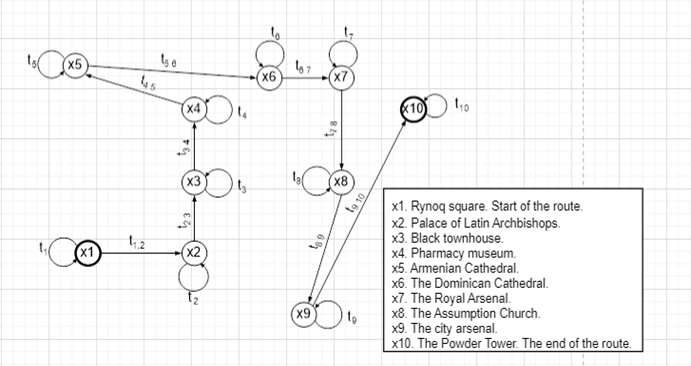Development of information system for planning personalized tourist routes
DOI:
https://doi.org/10.15587/2706-5448.2024.298422Keywords:
information system, tourism industry, graph theory, personalized planning, optimal routes, unique tourist experienceAbstract
The object of research is processes of information and technological planning of tourist trips. The article analyzes the processes of information technology planning of tourist trips and develops an information system for personalized planning of tourist routes using graph theory. The paper describes in detail a new approach to the formation of optimal routes based on graph models and the analysis of personal preferences of users.
The developed information system uses graph theory to represent and optimize tourist routes, taking into account various criteria such as distance, travel time, and individual user preferences. Algorithms for calculating optimal routes are designed to improve the quality of recommendations and provide a high level of personalization.
The functionality of the information system for planning tourist routes is based on the use of a number of innovative approaches and technologies that make the system more efficient, accurate and attractive to users. This takes into account the need to use modern route optimization algorithms. Algorithms have been developed to optimize tourist routes based on various criteria, such as cost, time, personal preferences, and environmental aspects. The introduction of intelligent analytical tools for predicting tourist trends helps to determine the popularity of places and other factors that influence the choice of routes. For the audio support of the excursion route, an algorithm for generating multimedia information content that is relevant to an individual personalized excursion route and its duration is used. The authors formulate the requirements and analyze the functionality of the information system for personalized planning of tourist routes, since a personalized approach and the use of graph models facilitate route planning that takes into account various aspects, including user-friendliness, accuracy of recommendations, system flexibility and security.
The developed information system can open up new opportunities for individual and intelligent planning of tourist routes, providing users with a unique tourist experience.
References
- Labunska, S., Zyma, O., Sushchenko, S. (2022). The use of information systems as a way to ensure interaction between small and big tourism enterprises. Access Journal – Access to Science, Business, Innovation in the Digital Economy, 3 (1), 16–28. doi: https://doi.org/10.46656/access.2022.3.1(2)
- Robb, M. C. (1987). Route information systems for motorists. Transport Reviews, 7 (3), 259–275. doi: https://doi.org/10.1080/01441648708716659
- Ebner, A.; Schertler, W., Schmid, B., Tjoa, A. M., Werthner, H. (Eds.) (1994). TIS Tourism Information System for the Tyrol. Information and Communications Technologies in Tourism. Vienna: Springer, 35–42. doi: https://doi.org/10.1007/978-3-7091-9343-3_6
- Almer, A., Schnabel, T., Stelzl, H., Stieg, J., Luley, P.; Carswell, J. D., Tezuka, T. (Eds.) (2006). A Tourism Information System for Rural Areas Based on a Multi Platform Concept. Web and Wireless Geographical Information Systems. W2GIS 2006. Lecture Notes in Computer Science. Vol 4295. Berlin, Heidelberg: Springer, 31–41. doi: https://doi.org/10.1007/11935148_4
- Miočić, B. K., Vidić, G., Klarin, T. (2014). Comparative analysis of tourist satisfaction and online booking services usage for incoming tourists in Zadar County. 2014 37th International Convention on Information and Communication Technology, Electronics and Microelectronics (MIPRO). Opatija, 1544–1549. doi: https://doi.org/10.1109/mipro.2014.6859811
- Abuelrub, E. M., Solaiman, H. M. (2010). A Tourism e-Guide System Using Mobile Integration. International Journal of Interactive Mobile Technologies (IJIM), 4 (2), 4. doi: https://doi.org/10.3991/ijim.v4i2.1051
- Tallinucci, V., Zehrer, A., Pechlaner, H. (2004). Using Interactive Maps as Tourism Information Source: The Case of DESTOUR. Information and Communication Technologies in Tourism 2004, 49–57. doi: https://doi.org/10.1007/978-3-7091-0594-8_5
- Huk, K., Kurowski, M. (2021). Innovations and new possibilities of vehicle tracking in transport and forwarding. Wireless Networks, 28 (1), 481–491. doi: https://doi.org/10.1007/s11276-021-02623-0
- Bedair, S., Sayed, S. A., AlMetwaly, W. M. (2022). Enhancing Hybrid Learning using Open Source GIS-Based Maps Archiving System. The Egyptian Journal of Remote Sensing and Space Science, 25 (3), 779–793. doi: https://doi.org/10.1016/j.ejrs.2022.07.003
- Cranmer, E. E., tom Dieck, M. C., Fountoulaki, P. (2020). Exploring the value of augmented reality for tourism. Tourism Management Perspectives, 35. doi: https://doi.org/10.1016/j.tmp.2020.100672
- Yang, J., Zheng, B., Chen, Z. (2020). Optimization of Tourism Information Analysis System Based on Big Data Algorithm. Complexity, 2020, 1–11. doi: https://doi.org/10.1155/2020/8841419
- Sustacha, I., Baños-Pino, J. F., Del Valle, E. (2023). The role of technology in enhancing the tourism experience in smart destinations: A meta-analysis. Journal of Destination Marketing & Management, 30. doi: https://doi.org/10.1016/j.jdmm.2023.100817
- Fernandes, R. P. A., Almeida, J. E., Rosseti, R. J. F. (2013). A Collaborative Tourist System Using Serious Games. Advances in Information Systems and Technologies, 725–734. doi: https://doi.org/10.1007/978-3-642-36981-0_67

Downloads
Published
How to Cite
Issue
Section
License
Copyright (c) 2024 Artur Kondra, Valeriia Savchuk, Sergiy Pasichnyk, Nataliia Kunanets, Hanna Мashika

This work is licensed under a Creative Commons Attribution 4.0 International License.
The consolidation and conditions for the transfer of copyright (identification of authorship) is carried out in the License Agreement. In particular, the authors reserve the right to the authorship of their manuscript and transfer the first publication of this work to the journal under the terms of the Creative Commons CC BY license. At the same time, they have the right to conclude on their own additional agreements concerning the non-exclusive distribution of the work in the form in which it was published by this journal, but provided that the link to the first publication of the article in this journal is preserved.







